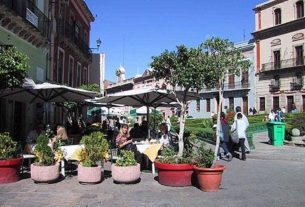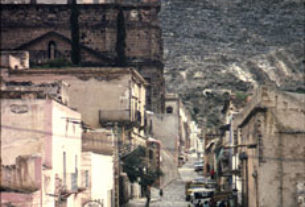Sealed off by mountains to both the East and West, and arid, desert-like land to the North, Mexico’s central altoplano, for eons was home to Nahua, Otomi, Huichol, Cora, Tepehua and Coyutec Indians. Only the Chichimecs, who lived in the foothills of the Eastern mountain range were warlike. It was a fertile, peaceful region, never dominated by the Aztecs. But in 1530, Nuneo Beltran de Guzmán led an expedition that brought what are now the Mexican States of Jalisco, Nayarit, Aguascaliente, Durango, Sinaloa and Zacetecas under Spanish control. In doing so, he destroyed the way of life for all the indigenous people who inhabited the area.
He had come to New Spain after the Conquest, appointed to be Governor of Panuco, a State in N.E. Mexico. In 1528 he became president of the first Audiencia of New Spain. The Audenci was a court, set up to investigate charges leveled against Hernando Cortez and to replace the military government Cortez had headed since the fall of the Aztec Empire.
An avowed enemy of Cortez, Guzmán was unable to bring him to trial because the leader of the original Conquest had returned to Spain to refute the charges. Arbitrary and unreasonable in his dealings with his fellow Spaniards and brutal in dealing with the Indians, by 1529 Guzmán’s conduct had caught the eye of Juan de Zumarraga, Archbishop of New Spain. In January of 1530, he excommunicated and dissolved the Audiencia. Perhaps forewarned, Guzmán resigned his post in December of 1529. Organizing an army of 500 discontented former Conquistadors and 10,000 Indians, with funds illegally obtained, he headed North.
The Tarascans, who inhabited what is now Michoacan, were fierce warriors. Never conquered, they had sealed off Northwest and Northcentral Mexico from Aztec domination. Guzmán chose to by-pass their homeland.
The indigenous people of Northwest and North Central Mexico have left little behind for archeologists to study. Only shaft graves attest to their presence. They built no large cities. Semi-nomadic, they wintered in caves in the nearby Western Sierra Madre Mountains and spent the rest of the year on the fertile altoplano. They raised corn, domesticated some animals, hunted and fished. The Clan and the Tribe were their social organizations. They had no concept of a nation. Today only the Huichols survive and retained their identity. Their legends give us some insight to life before Guzmán. Unlike the Aztecs, their religions were spiritual, relying on the use of peyote, hallucinogenic mushrooms and intoxicating beverages to put themselves in touch with their Gods. Human sacrifice was unknown.
Unlike the first wave of Spaniards who claimed land for the Crown and were sincerely interested in converting the Indians to Christianity, Nuño Beltran de Guzmán sought only power and land for himself. He established economiendos, private land grants for himself and his Spanish followers. When it suited him, he even seized land previously granted to other Spaniards. Indians could own no land. Even his Indian allies were mistreated.
Freed from the moderating influences of churchmen like Bartolome de las Casas, a Bishop who in 1520 proclaimed that Indians had souls, and Archbishop Zumarraga who had thwarted him in New Spain, local Indians were either slaughtered or enslaved.
Their only hope for survival was to abandon the altoplano completely and retreat deep into the mountains.. His treatment of the Indians earned him the nickname of “Bloody Guzmán.” His actions stirred up hate and resentment that would haunt him as well as the Spaniards who now came to colonize the area.
He had named it New Galicia in honor of the province in Spain where he had been born In January, 1532 he tried to found a capital, Guadalajara, named after the city of his birth. Located south of present day Zacatecas, it was quickly and repeatedly attacked by the Chichimacs. In August 1533, the site was abandoned and a new location near present day Tonala was selected. But now Guzmán himself interfered by claiming the land for himself.
The city was moved to Tlacotan, a location north-east of present day Zapopan. The high handed actions that had forced this third relocation, antagonized the settlers who had to start building a city all over again, and the Viceroy of New Spain, Antonio de Mendoza, began to receive complaints.
By now, Franciscan Fathers had arrived in New Galicia, and reports of the brutal treatment of the Indians started reaching Mexico City. Egged on by both Bishop de las Casas and Archbishop Zumarrago, in 1536, Mendoza arrested Guzmán and imprisoned him. Returning to Spain, he died in obscurity.
Despite his removal, in 1541, the Indians now banded together, attacked Guadalajara, and attempted to drive the Spaniards out of New Galicia. Called the Mixton War, this was the first time since the Conquest that indigenous people had attacked a Spanish settlement. Unable to handle the situation, Cristobal de Onate, the acting Governor and a henchman of Guzmán, was forced to call on the Viceroy for help.
Help came and the uprising was crushed, but now control of New Galicia reverted to the Colonial Government of New Spain.
The city was now moved for the fourth time to its present location and on February 14, 1542 Guadalajara was recognized as the official Capital of New Galicia. The second largest city in Mexico, it is now the Capital of Jalisco.
Nuño Beltran de Guzmán is a blot on Mexican history. His only real contribution to Guadalajara is its name. The Indian population of Jalisco, aside from the Huichols, who live in poverty deep in the mountains, is miniscule. He decimated them. More than 400 years later, the indigenous people of Northern Mexico are still his victims.



My family is one of the few descendants of the cuyuteco luckily we didn’t face Guzman’s wrath but we were mostly whipped out by the cultural suppression from the spainish